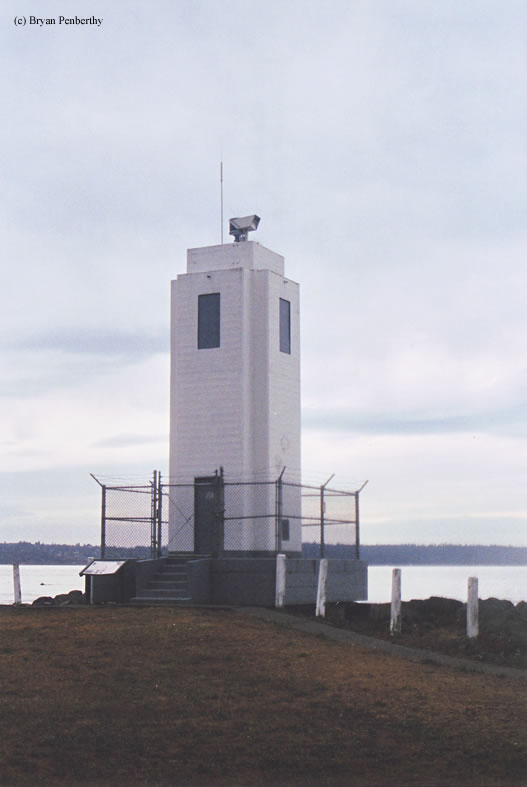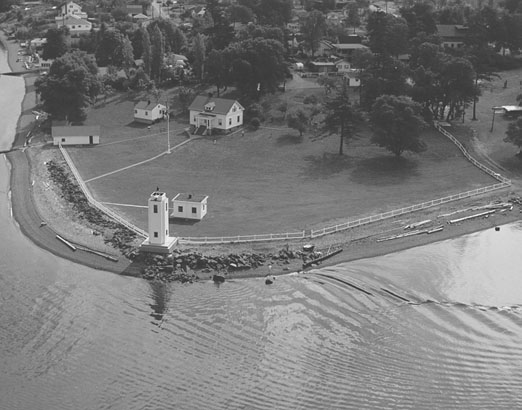Browns Point Lighthouse
Tacoma, Washington - 1933 (1887**)

History of the Browns Point Lighthouse
Posted/Updated by Bryan Penberthy on 2006-02-06.
Starting around the 1700s, explorers spent considerable time on the West Coast surveying and assigning names to physical features of the land. Sent by King George III of England, George Vancouver named many locations in the area, including Puget Sound and Gig Harbor in 1792.
Surveying and mapping for the United States, Lieutenant Charles Wilkes explored the area in 1841. He assigned the name Point Harris to the location just north of Commencement Bay. It was around this time that settlers from points east began migrating into the area.
Native Americans had used the land around Point Harris for centuries to fish, crab, hunt deer, and pick berries. As the white men came into the area in the mid-1800s and began to settle the lands, conflicts arose. After several wars, the Medicine Creek Treaty was signed in 1854 which created the Puyallup Reservation.
Another survey of the area in 1877 by Navy Lieutenant Ambrose Barkley Wyckoff renamed Point Harris to Point Brown on his charts. By 1886, Individual members of the Puyallup Tribe received patent deeds to 160 acre sections of private property within the reservation. A member named Joe Douette acquired a large portion of Point Brown.
As marine traffic in and out of Commencement Bay increased in the mid to late 1800s, the United States Lighthouse Board erected a kerosene light on a pole at Browns Point, the turning point for vessels heading into Commencement Bay and the small town of Tacoma. The pole light had no keeper, instead a lamplighter from Tacoma would go out to the site to clean, refuel, and relight the lamp every eight days.
As fog frequented the area for long periods, many near collisions occurred. The Annual Report of the Lighthouse Board dated 1894 had the following entry:
1004. Point Brown post light, Puget Sound, Washington - In addition to the stake light at this important turning point of the numerous water crafts plying between Tacoma and points down the sound a fog signal is urgently required. It is estimated that a bell struck by machinery could be erected, together with the necessary buildings, dwellings, etc., for about $6,000, and it is recommended that an appropriation of this amount be made therefor.
The entry was repeated again in the reports from 1895 to 1899. An Act of Congress dated June 6, 1900 provided the appropriation of $6,000 to establish a new lighthouse and fog signal at Browns Point. At that time, the Lighthouse Board started work on the plans and specifications for the project.
The following year, the U.S. Government attempted to purchase land for the lighthouse, however; as the cost was deemed excessive, the government started condemnation proceedings in 1901. By 1902, the case had made its way through the courts, and the plot of land was conveyed to the United States. The Annual Report of the Lighthouse Board dated 1903 had the following thorough entry:
192. Browns Point, Washington - Congress, by act approved on June 6, 1900, appropriated $6,000 to establish a light and fog-signal station at Browns Point, on Commencement Bay, entrance to harbor of Tacoma, Washington. The prices asked by the owners of the site were excessive, and the land was condemned. The case was tried in the United States circuit court, and the site was conveyed absolutely to the United States, and damages to the amount of $3,000 were decreed in the case. This excessive price made an additional appropriation of $3,200 necessary, which was made by the act approved on June 28, 1902. On September 22, 1902, the Board approved the plans and specifications for constructing the station, and on January 9, 1903, the only bid received was opened, and that was in the sum of $6,090. This amount being in excess of the appropriation, the bidder submitted a modified proposal in the sum of 5,300, which was accepted, and contract was made on March 5, 1903, providing that the station should be completed by September 25, 1903. The basement walls of the dwellings are finished, and the fog-signal building is ready for shingling.
 1903 Browns Point Light (Courtesy Coast Guard)
1903 Browns Point Light (Courtesy Coast Guard)
Per the contract, the station was completed in September of 1903. Oscar Brown, the station's first keeper, arrived at the aptly named Point Brown on October 26, 1903. It was at this time that the name was officially changed to Browns Point in a 1903 Notice to Mariners by the Department of Commerce and Labor.
When Keeper Oscar Brown and his wife Annie's belongings arrived via lighthouse tender, the crew dropped their belongings on the beach, and left. Some of the items dropped off included a cow, horse, and upright grand piano. As there were no other inhabitants around, there was no help to move in.
It would take the Browns five days to move most of their belongings into the house, but the piano stayed put on the beach, often times in the rain, for nearly a week until help arrived from Tacoma to move it indoors.
The first year, Keeper Brown spent collecting up wood, fixing up some of the shacks and removing others that were left on the property by the heirs of landowner Joe Douette, and laying wooden planks for sidewalks. Other work included planting a garden for food, setting up feed bins and water troughs for the animals, and collecting fruit from the local trees.
A boathouse was added to the station in 1905.
By 1913, the area around the lighthouse was being encroached upon by the community. Several entrepreneurs purchased large tracts of land and platted them. People soon set up camps and small cabins for summer vacations. It didn't take long before permanent residences were established as well. Suddenly, the Browns had neighbors and were locals in the community.
When a reporter from the Tacoma News Tribune asked Keeper Brown his feelings on the locals saying the point was named after him, he had the following to say, "No, it wasn't named after me. From all I can find out it was named by Vancouver's party who saw the mountain first from here. Being named Brown didn't have anything to do with my coming here either. Why, at Smith Island, they used to call me Smith."
Electricity arrived at Browns Point Lighthouse in 1922 easing the keeper's burden. The keeper could flip a switch in the dwelling and turn on the light in the tower. The fog signal was also adapted with an electric motor to automatically strike the bell.
Every November and December, Keeper Brown would spend his days cleaning up the yard due to high tides. In addition to creating a lagoon in the center of the station, the high tides would also wash away the tower's foundation. By the early 1930s, the situation was critical, requiring the tower be replaced.
Several tons of riprap were brought in to harden the shoreline. By June of 1933, a new concrete art-deco style lighthouse with a foghorn was established. Although the middle of the station was filled in with rocks, stones, and dirt, many times, it would continue to flood and a lagoon would form.
The fog bell from the original lighthouse was discontinued as the new station's fog signal utilized compressed air. The fog bell was sold for $50 to the College of Puget Sound and would be rung to signal the beginning and the end of classes. As it was always struck in the same location, a crack formed. It was discontinued from use, and in 1984, it was donated to the Fox Island Alliance Church where it would signal the start of service.
The Coast Guard took over the duties of the U.S. Lighthouse Service in 1939. At that time, Oscar Brown retired. His replacement was Boatswain's Mate First Class Arthur "Shorty" Woods who would serve until 1944.
A civilian keeper named Cyril F. Beaulieu was appointed as keeper at Browns Point at that time. During his tenure, additional duties were added. Included were controlling the light and foghorn at the nearby Point Defiance station across the Puget Sound, but within view of Browns Point. Two additional men were assigned to the station to assist with the duties. Keeper Beaulieu retired in 1956.
 1933 Browns Point Lighthouse (Courtesy Coast Guard)
1933 Browns Point Lighthouse (Courtesy Coast Guard)
Several additional keepers were assigned to the station over the years, but Boatswain's Mate First Class Robert Deason was the last keeper before the lighthouse was automated in 1963. At that time, the Browns Point Lighthouse was leased to Metro Parks Tacoma.
The tower received an upgrade in February of 1970 when the Coast Guard, utilizing a helicopter, removed and reinstalled the 431-pound lens assembly over new quartz-iodide lamps. The new lamps had a longer life span and didn't dim with age.
The Points Northeast Historical Society, which was incorporated in 1986, had the Browns Point Lighthouse added to the National Register of Historic Places in 1989, and entered into an agreement with Metro Parks Tacoma in 1990 to restore the buildings and create exhibits.
Over the years, the officers of the Points Northeast Historical Society tracked down the original fog bell to the Fox Island Alliance Church. After years of negotiations, the bell was returned to the Browns Point Lighthouse in 2001. Today it resides in the old pump house.
Today, the restored cottage, with period furnishings, is available to rent, allowing people to become honorary lighthouse keepers. Chores include raising and lowering the flag, logging weather and shipping traffic, and opening the cottage and museum for visitors.
Reference:
- "Browns Point Fogbell in Tacoma, Washington," Mavis Stears, Lighthouse Digest, January / February 2006.
- "Browns Point Lighthouse: One of Best Light Stations to Stay At, Is Also Rich in History," Mavis R. Stears, Lighthouse Digest, March / April 2013.
- Points Northeast Historical Society website.
- Annual Report of the Light House Board, U.S. Lighthouse Service, Various years.
Directions: Exit the I-5 Freeway at exit 147 (Military Road South) and head south to S 288th Street. Make a right onto 288th Street, and follow that back to SR-99 (Pacific Highway South). Make a left onto SR-99 and go less than a half of a mile to SR-509 (South Dash Point Road). Follow this road for about 8 miles. It does eventually change names to East Side Drive NE. At Hyada Blvd. NE, make a right and follow that to the end. Then make a right on Wan I DA Ave NE and a quick left onto Tulalip Street NE. At the end of this road is the Browns Point Lighthouse.
Access: The tower is owned by The U.S. Coast Guard. Grounds open. Dwelling open during tours and for rentals.
View more Browns Point Lighthouse picturesTower Height: 34.00'
Focal Plane: Unknown
Active Aid to Navigation: Yes
*Latitude: 47.30600 N
*Longitude: -122.44400 W
See this lighthouse on Google Maps.
